Citation: Christian M Julien, Alain Mauger, Ashraf E Abdel-Ghany, Ahmed M Hashem, Karim Zaghib. Smart materials for energy storage in Li-ion batteries[J]. AIMS Materials Science, 2016, 3(1): 137-148. doi: 10.3934/matersci.2016.1.137
| [1] | Christian M. Julien, Alain Mauger . Functional behavior of AlF3 coatings for high-performance cathode materials for lithium-ion batteries. AIMS Materials Science, 2019, 6(3): 406-440. doi: 10.3934/matersci.2019.3.406 |
| [2] | Christian M. Julien, Alain Mauger . In situ Raman analyses of electrode materials for Li-ion batteries. AIMS Materials Science, 2018, 5(4): 650-698. doi: 10.3934/matersci.2018.4.650 |
| [3] | Alain Mauger, Haiming Xie, Christian M. Julien . Composite anodes for lithium-ion batteries: status and trends. AIMS Materials Science, 2016, 3(3): 1054-1106. doi: 10.3934/matersci.2016.3.1054 |
| [4] | Claas Hüter, Shuo Fu, Martin Finsterbusch, Egbert Figgemeier, Luke Wells, Robert Spatschek . Electrode–electrolyte interface stability in solid state electrolyte systems: influence of coating thickness under varying residual stresses. AIMS Materials Science, 2017, 4(4): 867-877. doi: 10.3934/matersci.2017.4.867 |
| [5] | Michael A. Stamps, Jeffrey W. Eischen, Hsiao-Ying Shadow Huang . Particle- and crack-size dependency of lithium-ion battery materials LiFePO4. AIMS Materials Science, 2016, 3(1): 190-203. doi: 10.3934/matersci.2016.1.190 |
| [6] | Rucheng Zhu, Yota Mabuchi, Riteshkumar Vishwakarma, Balaram Paudel Jaisi, Haibin Li, Masami Naito, Masayoshi Umeno, Tetsuo Soga . Enhancing in-plane uniformity of graphene nanowalls using a rotating platform for solid-state lithium-ion battery. AIMS Materials Science, 2024, 11(4): 760-773. doi: 10.3934/matersci.2024037 |
| [7] | Hiroki Nara, Keisuke Morita, Tokihiko Yokoshima, Daikichi Mukoyama, Toshiyuki Momma, Tetsuya Osaka . Electrochemical impedance spectroscopy analysis with a symmetric cell for LiCoO2 cathode degradation correlated with Co dissolution. AIMS Materials Science, 2016, 3(2): 448-459. doi: 10.3934/matersci.2016.2.448 |
| [8] | Ehsan Harati, Paul Kah . Laser welding of aluminum battery tab to variable Al/Cu busbars in Li-ion battery joint. AIMS Materials Science, 2022, 9(6): 884-918. doi: 10.3934/matersci.2022053 |
| [9] | Fahmi Astuti, Rima Feisy Azmi, Mohammad Arrafi Azhar, Fani Rahayu Hidayah Rayanisaputri, Muhammad Redo Ramadhan, Malik Anjelh Baqiya, Darminto . Employing Na2CO3 and NaCl as sources of sodium in NaFePO4 cathode: A comparative study on structure and electrochemical properties. AIMS Materials Science, 2024, 11(1): 102-113. doi: 10.3934/matersci.2024006 |
| [10] | Anshu Mli Gaur, Dinesh Singh Rana . Investigation of structural, dielectric and sensing properties of MgCl2/PVDF composite films prepared via solution casting technique. AIMS Materials Science, 2016, 3(3): 1117-1124. doi: 10.3934/matersci.2016.3.1117 |
Smart materialsare designed as compounds exhibiting properties that can be significantly changed in a controlled fashion by external stimuli, such as electric field in the case of energy storage and conversion devices [1]. The reaction may exhibit itself as electricity production (batteries, supercapacitors), change in color (smart windows, electrochromics), catalytic effect, etc. Advanced lithium-ion batteries contain several smart materials having specific and complementary function such as insertion electrodes, i.e. cathode and anode, and separator [2].
Insertion compounds (ICs) have peculiar properties of mixed conduction for both electrons and ions, so that the redox reaction can be delocalized in their volume, the reason why they can be used as active materials of electrodes [3]. Their high capability to host foreign ions depends of several factors: structure, transport, particle shape, etc., so that the relationship between structure and electrochemical features has been evaluated with special attention. For materials currently used as positive electrode in lithium batteries, the different crystal chemistries are examined from the basic reaction driven by charge transfer from the guest Li+ ions to the conduction band of the host compound. Thus electron-donating species can take place in a reversible reaction classically represented by the scheme:
| xA+ + xe- + 〈H〉 ↔ [Ax+〈H〉x-], | (1) |
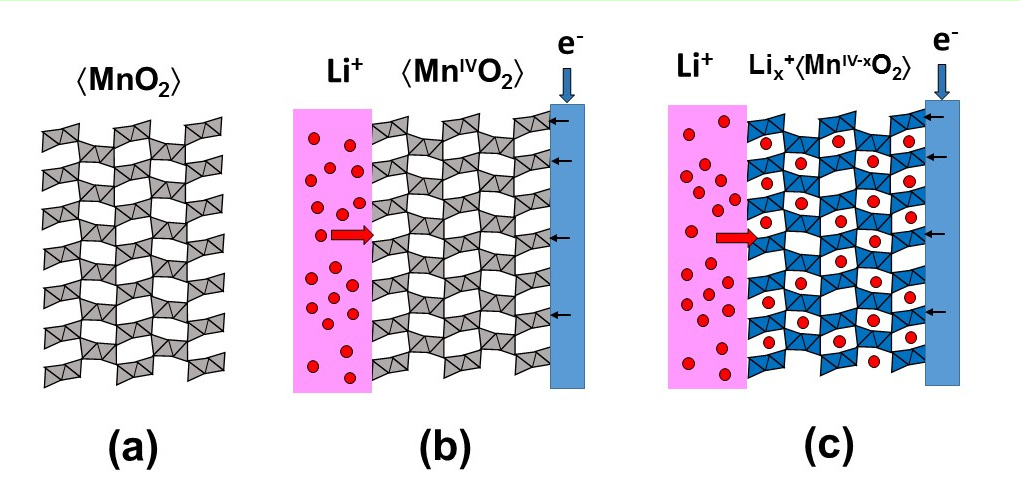 Figure 1. Scheme of the insertion mechanism. (a) The tunnel framework of the MnO2 cathode material, (b) charge state of the MnIVO2 electrode with empty sites and (c) partial discharge state for which manganese cations are in the (4-x) oxidation state.
Figure 1. Scheme of the insertion mechanism. (a) The tunnel framework of the MnO2 cathode material, (b) charge state of the MnIVO2 electrode with empty sites and (c) partial discharge state for which manganese cations are in the (4-x) oxidation state.
In this paper, we describe some advanced “smart systems” having very sophisticated structures that were elaborated in the view of use as active materials for electrodes in high-power lithium batteries for electric vehicles (EVs). Such an application requests several advantages with regard to low cost, non-toxicity, environmental friendless and high safety associated with remarkable chemical and thermal stabilities and tolerance to overcharge and over-discharge. These smart systems include surface modified compounds, blended materials and nano-composites. The cathode materials such as LiNi1/3Mn1/3Co1/3O2 (NMC), Li[Li0.1Mn1.85Al0.05]O4 (LMA), LiMn2O4 (LMO), Li1.2Ni0.13Mn0.54Co0.13O2 (Li-rich NMC), Li4/3Mn5/3O4, LiFePO4 (LFP), LiMnPO4 (LMP), and the anode material nano-Li4Ti5O12 have been selected here, since these the best representatives of the progress that has been achieved these recent years.
A constant progress to improve the calendar and the cycling life of electrodes in Li-ion batteries without sacrificing the safety issues is obtained owing to the surface treatment of the electrode particles. Fabricating smart materials by the coating of particles with a thin layer (~ 2-3 nm) that protects the core region from side reactions with the electrolyte, i.e. formation of the solid-electrolyte interphase (SEI), prevents the loss of oxygen and the dissolution of the metal ions in the electrolyte, or simply improves the conductivity of the powder [4]. Figure 2 shows the realization of a phosphate coating onto NMC particle by a moderate heat treatment (Ta < 700 °C).
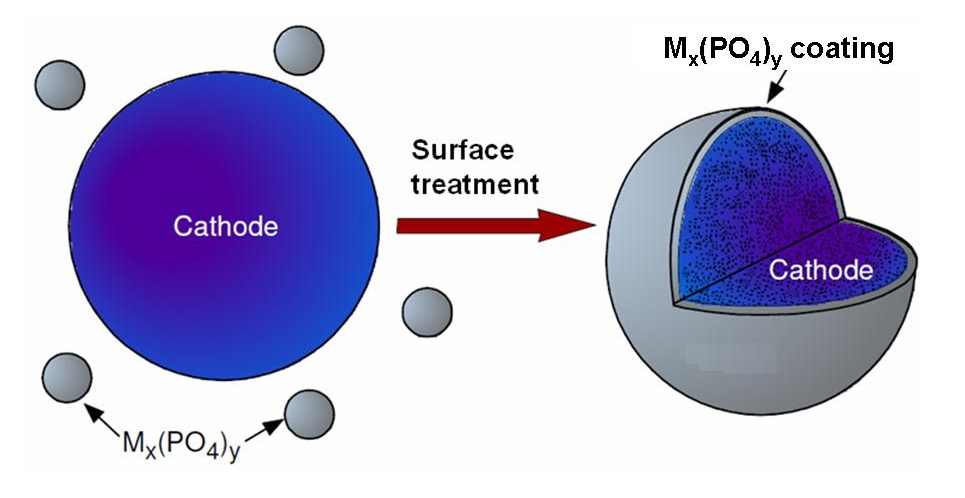 Figure 2. Scheme showing the preparation of NMC cathode particle coated by surface treatment.
Figure 2. Scheme showing the preparation of NMC cathode particle coated by surface treatment.
The use of lithium transition-metal oxides such as NMC, which exhibit poor cycling stability, is limited because of the formation of a SEI at high cut-off voltage and thermal runaway at high rate. Nevertheless, improvements can be achieved by fabricating a smart material with a special surface treatment (coating) that aims to protect the particles against the electrolyte. Various substances, Al-based oxides and phosphates, i.e. Al2O3, AlPO4, and also ZrO2 are widely used [4]. Among them, ZrO2 is of particular interest as it exhibits a negative zeta potential, basic surface, and strongbonding, which are beneficial for trapping HF that is formed in LiPF6 organic carbonate electrolytes, and maintaining the chemical stability. A 2.5-nm thick zirconia coating (Fig.3a) is efficient for decreasing the irreversible capacity loss of NMC particles during the high potential cycling. Figure 3b shows the specific capacity for spherical shape particles (8 µm size) of pristine and 1 wt.% ZrO2-modified NMC cathode obtained from ZrO(NO3)2 dissolved inethanol [5]. The comparison between performance of uncoated and ZrO2-coated NMC (Fig.3b) shows that the surface modified electrode preserves a specific capacity of 170 mAh g−1 after 120 charge-discharge cycles.
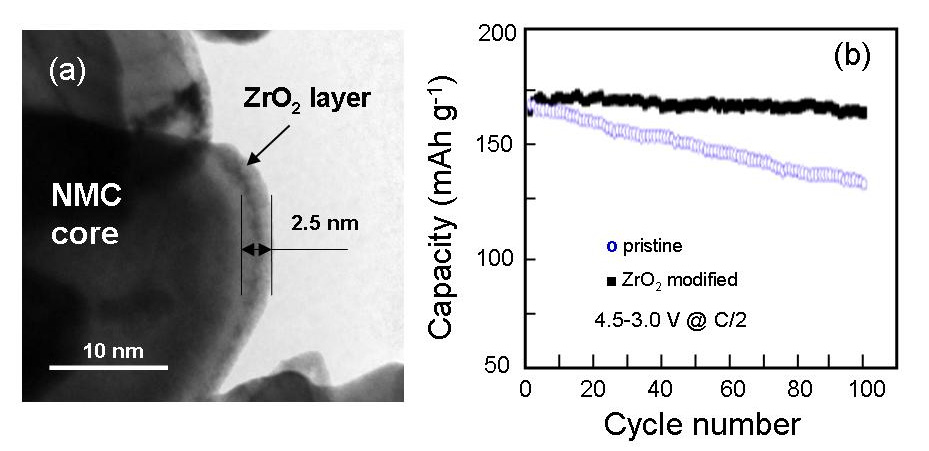 Figure 3. (a) TEM image of a ZrO2-coated NMC particle [5]. Coating was obtained using ZrO(NO3)2 that was first dissolved in ethanol. (b) Discharge specific capacity of pristine and 1 wt.% zirconia-modified NMC cathode, with Li metal as counter-electrode. The cathodes were charged and discharged at C/2 rate in the 3.0-4.5 potential range.
Figure 3. (a) TEM image of a ZrO2-coated NMC particle [5]. Coating was obtained using ZrO(NO3)2 that was first dissolved in ethanol. (b) Discharge specific capacity of pristine and 1 wt.% zirconia-modified NMC cathode, with Li metal as counter-electrode. The cathodes were charged and discharged at C/2 rate in the 3.0-4.5 potential range.
Recently, a highly uniform coating layer has been obtained by sputtering zirconium oxide on LMC [6]. These authors have determined that the surface is coated with ZrO2, while Zr2+ is detected below the surface layer, acting as a dopant. The overall process was then called ZrOx-coating. Cycling testing was conducted by using the constant current followed by holding the constant voltage (4.5 V for 30 min) in the potential range of 3.0-4.5 V vs. Li0/Li+ , and the C-rate was fixed at 1C (160 mA g−1), except for the first 2 cycles (formation cycles, C-rate of C/4). The capacity was still stabilized at 150 mAh g−1 after 200 cycles.
LiMn2O4 (LMO) spinel is an attractive cathode element, mainly because its thermal stability is much better than that of the lamellar compounds such as LiCoO2 [7]. However, it suffers from poor cycling behavior. The dissolution of manganese in the electrolyte is of major concern [8], since it reduces the calendar life of the battery. In addition, the kinetics of this reaction of LMO with the electrolyteincreases with the temperature, so that LMO particles need a special treatment. To overcome the problem of poor cycling, it was suggested that both Li and Al doping in Mn sites of LMO spinel avoid Mn dissolution [9] and a surface-modified Li[Li0.1Mn1.85Al0.05]O4 (LMA) by bismuth oxyfluoride (BiOF) coating has improved electrochemical properties [10]. The advantage of fluoride is that it is stable in HF. Since BiOF is not electro-active, the coating decreases the capacity, but it increases very much the capacity retention at high temperature. Recently, results have been obtained with BiOF-coated LMA, since the irreversible capacity loss after 100 charge-discharge cycles is significantly reduced. Figure 4 presents the HRTEM images of pristine BiOF-coated spinel particles after 100 cycles. Comparable improvements have been observed by coating AlF3 on Li1.1Al0.05Mn1.85O4 [11] and LiMn2O4 coated with 2.92 wt.% LaF3 displays capacity [12].
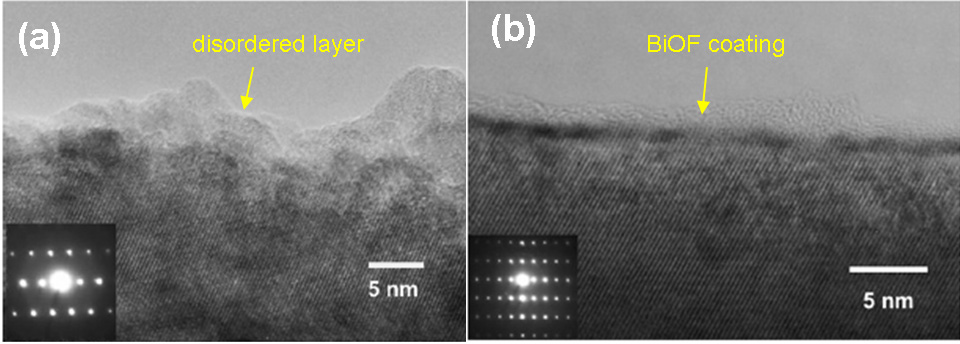 Figure 4. HRTEM images of Li[Li0.1Mn1.85Al0.05]O4 particles after 100 charge-discharge cycles [10]. Structural damage occurs on the surface the pristine spinel (a) while the surface of particle is well preserved with the BiOF-coating (b).
Figure 4. HRTEM images of Li[Li0.1Mn1.85Al0.05]O4 particles after 100 charge-discharge cycles [10]. Structural damage occurs on the surface the pristine spinel (a) while the surface of particle is well preserved with the BiOF-coating (b).
Another route that has been used recently is coating LiMn2O4 with a carbon layer, typically 1.5 nm thick. The C-LiMn2O4 composite cathode maintains 97.76% of its initial discharge capacity after 100 charge-discharge cycles at C/10 rate, proving that the carbon layer avoiding the core material direct contact with the acidic electrolyte and suppression of Mn dissolution into electrolyte [13]. The current strategy to synthesize nanowires is to use self-support template, which is not suited at mass production. However, it is now possible to prepare carbon-coated LiMn2O4 nanowires without using a template [14]. The cathode prepared with C-LiMn2O4 nanowires adds the advantage of the nano-size of the wires, to obtain high-rate performance, and carbon protection to obtain long cycling life: Even after 1500 cycles at an extremely high current density of 30C, approximately 82% of its initial capacity can still be retained.
Carbon coated LiFePO4 nanoparticles were used as surface coating agents for the 5-V electrode LiMn1.5Ni0.5O4 spinel. A new mechano-fusion dry process was used, which provides a simple way to obtain surface coating for battery materials. Surface elemental analyses indicate that LiFePO4 nanoparticles were not simply mixed with the LiMn1.5Ni0.5O4, but successfully coated on its surface. This new composite was tested as a cathode for Li-ion batteries. LiMn1.5Ni0.5O4 showed better capacity retention after LiFePO4 coating, especially at high rate (>10C) as shown in Fig.5. After 100 cycles at 1C, the capacity declined from 105 to 65 mAh g-1 for the bareLiMn1.5Ni0.5O4. In contrast, 82 mAh g-1 of capacity was still obtained for the LiFePO4-coated LiMn1.5Ni0.5O4 with 75% of capacity retention after 140 cycles under 1C. The results suggest that the improved performance is due to the increasing of the surface conductivity due to the carbon coated LiFePO4 covering, and the protection against reactions of LiMn1.5Ni0.5O4 with the electrolyte [15].
 Figure 5. Discharge profiles of the Li//LFP-coated LMN cells at different C rates. The LFP coated was realized by mechano-fusion dry process [12].
Figure 5. Discharge profiles of the Li//LFP-coated LMN cells at different C rates. The LFP coated was realized by mechano-fusion dry process [12].
To overcome the difficulty of carbon coating on LiMnPO4 (LMP) olivine particles, it is possible to coat LiMnPO4 with a thin layer of LiFePO4 (10-20 nm) that takes benefit of the catalytic reaction of Fe with C, so that a 3 nm-thick layer of carbon can be deposited at the surface of this composite (Fig.6) [16]. Using such a composite, the electrochemical properties of the carbon-coated LFP-LMP electrode are improved with respect to the carbon-coated LiMn2/3Fe1/3PO4 solid solution with comparable Fe/Mn ratio (Fig.7). Therefore, the use of a LiFePO4 as a buffer layer between the high-density cathode element (like LiMnPO4) and the carbon layer opens a new route to improve the performance of the olivine family as the active element of the cathode for Li-ion batteries. This result is attributable to the fact that the LFP shell allows for the coating of the composite, while it is difficult to deposit the carbon at the surface of LMP at temperature small enough to avoid its decomposition. This carbon layer improves the electrical contact between the particles, and consequently the performance at high C-rate. In addition, the LFP layer may avoid side reactions with the electrolyte, since the electrochemical properties do not degrade upon cycling, at least during the 100 first cycles that have been tested. The synthesis of composite particles of active elements of the olivine family is thus a promising route to improve the energy density of future Li-ion batteries, since both the LFP and the LMP are active materials, and the composite takes benefit of the higher redox potential of Mn2+/Mn3+ vs. Li0/Li+.
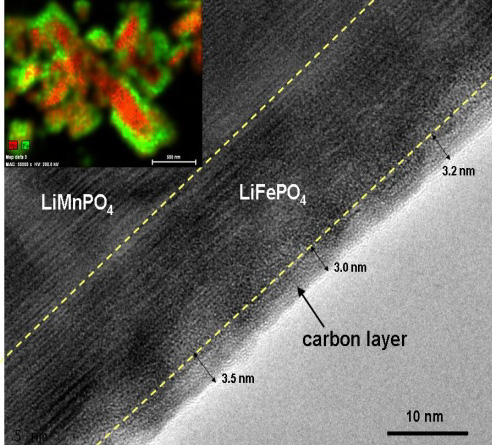 Figure 6. TEM image near the surface of LMP-LFP composite particle showing the different layers. Note the interface between LiMnPO4 and LiFePO4 is sharp and the carbon layer is continuous, but irregular, as a consequence of the rather low calcination temperature 600 °C. The typical EDX map of LMP (in red)-LFP (in green) particle is shown in the insert [16].
Figure 6. TEM image near the surface of LMP-LFP composite particle showing the different layers. Note the interface between LiMnPO4 and LiFePO4 is sharp and the carbon layer is continuous, but irregular, as a consequence of the rather low calcination temperature 600 °C. The typical EDX map of LMP (in red)-LFP (in green) particle is shown in the insert [16].
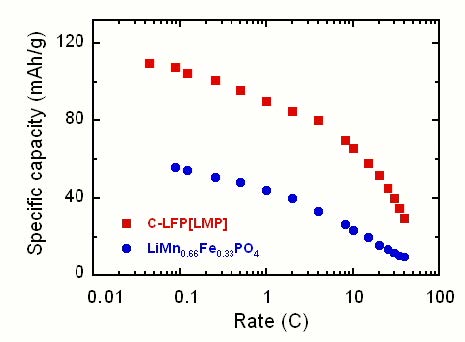 Figure 7. Modified Peukert plot of the C-LiFePO4-LiMnPO4 composite electrode compared with that of LiMn2/3Fe1/3PO4 solid-solution material. Similar overall ratio of Mn over Fe and same size d = 300 nm of particles were used for comparison [16].
Figure 7. Modified Peukert plot of the C-LiFePO4-LiMnPO4 composite electrode compared with that of LiMn2/3Fe1/3PO4 solid-solution material. Similar overall ratio of Mn over Fe and same size d = 300 nm of particles were used for comparison [16].
Blending electrodes is a new approach to design high-power battery for EVs [16,17]. The active material is formed by a mixture of two or more distinct lithium insertion compounds to achieve better balanced electrochemical performance than that of an individual compound (Fig.8).
 Figure 8. Scheme of a blended electrode composed by the layered LiNi0.8Co0.15Al0.05O2 and the spinel LiMn2O4.
Figure 8. Scheme of a blended electrode composed by the layered LiNi0.8Co0.15Al0.05O2 and the spinel LiMn2O4.
The widely used NMC material as positive electrode delivers limited power at low state-of-charge (SOC) level due to the increasedimpedance, which is an inherent character of layered oxides. For example, the bended positive electrode (cathode) composed of Li-rich NMC (Li1.2Ni0.13Mn0.54Co0.13O2) and Li4/3Mn5/3O4 (LMO) spinel exhibits a higher specific capacity, i.e. 250 mAh g-1 than the spinel structure and lower irreversible capacity loss than Li-rich NMC but the average potential is inferior, i.e. 3-4 V vs. Li0/Li+ [7]. Another example is provided by the blended electrode LiNi0.8Co0.15Al0.05O2-LiMn2O4 (NCA-LMO) with the (1/3:2/3) stoichiometry [19], of which the electrochemical properties are presented in Fig.9a-b. Illustrated by the Peukert plots (Fig.9b), the improved performance of the NCA-LMO blend shows that specific capacity 140 mAh g−1 is maintained at high 10C rate.
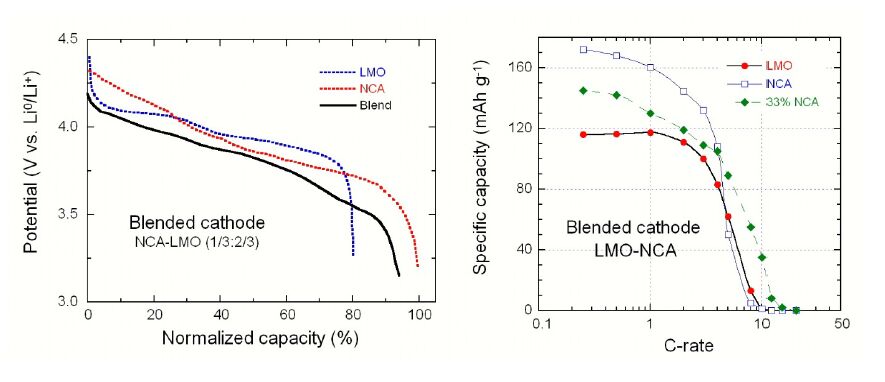 Figure 9. Electrochemical properties of the blended NCA-LMO electrode [19]. (a) Discharge curve of the blended electrode compared with those of components.(b) Peukert plot of the NCA-LMO compared with its single components.
Figure 9. Electrochemical properties of the blended NCA-LMO electrode [19]. (a) Discharge curve of the blended electrode compared with those of components.(b) Peukert plot of the NCA-LMO compared with its single components.
Another blended electrode is formed by the LFP-NMC system. LFP exhibits excellent rate capability by using nano-sized particles but delivers lower energy density than NMC, while NMC has a higher capacity, i.e. 180 mAh g−1 but its thermal stability is inferior that LFP [20]. Blended NMC-LFP electrode provides a good solution that achieves both energy and power capability. In the SEM image shown in Fig.10, one discerns the two distinct components of which this blend is fabricated with the composition NMC-LFP (70:30). This blended material prepared by ultra microtomy has shown large NMC particles (several micrometers) and small LFP particles (<0.5 µm), but no LFP coating on MNC is observed. This could be due to the mechanical force applied during the microtomy. The Peukert plots of the NMC-LFP (70:30) blended electrode cycled at different cut-off voltages are shown in Fig.11. These results indicate: (i) at low C-rate, the 4.8 V cut off provides the higher specific capacity of 180 mAh g−1 at C/10 rate but shows the lowest performance at high rates, (ii) higher capacity was obtained when the voltage cut-off is higher 4.1, 4.2 and 4.3 V, (iii) for the 4.1 V cut-off, the capacity fade less is pronounced, i.e. 0.12 mAh g−1 per cycle.
 Figure 10. SEM picture of (a) the pristine NMC powder and (b) the NMC-LFP (70:30) blended electrode showing distinct compounds and the 3 wt.% carbon additive.
Figure 10. SEM picture of (a) the pristine NMC powder and (b) the NMC-LFP (70:30) blended electrode showing distinct compounds and the 3 wt.% carbon additive.
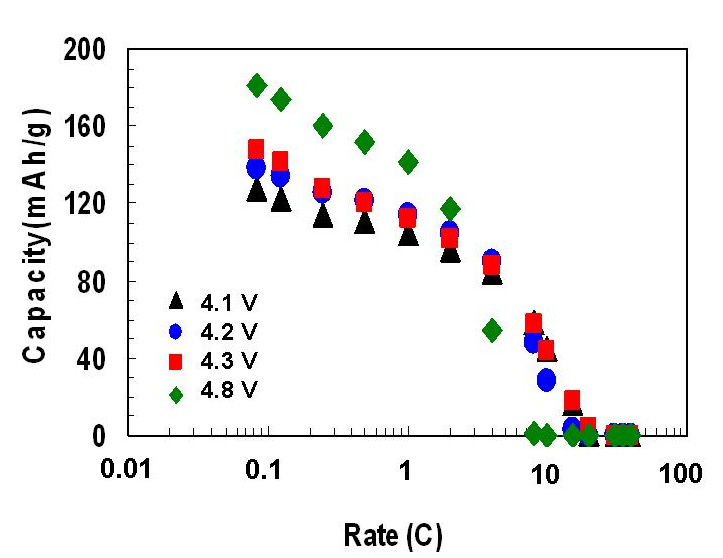 Figure 11. Specific capacity of the NMC-LFP (70:30) blended electrode as a function of C-rate in lithium cell cycled at differentcut-off voltages.
Figure 11. Specific capacity of the NMC-LFP (70:30) blended electrode as a function of C-rate in lithium cell cycled at differentcut-off voltages.
The spinel Li4Ti5O12 (LTO) is a zero-strain insertion compound, which exhibits excellent reversibility toward Li insertion/extraction [21]. On the other hand the high insertion potential (ca. 1.5 V vs. Li0/Li+) avoids the formation of the SEI and the reduction of the electrolyte. The preparation of a carbon-coated nanosized Li4Ti5O12 nanoporous micro-sphere was made by a carbon pre-coating process combined with the spray drying method. The resulting sample delivers a reversible capacity of 160 mAh g−1 at C/5 rate, and shows remarkable rate capability by maintaining 79% of the capacity at 20 C (vs. C/5) [22]. Wang et al. [23] shown that rutile-TiO2 as a carbon-free coating layer to improve the kinetics of LTO toward fast lithium insertion/extraction. The apparent chemical diffusion coefficient of Li+ ions is found to be 4× 10−13 cm2s−1, one order higher than pristine LTO. The preparation of LTO/carbon core-shell electrode was realized by using single-source carbon: metal acetate [24], single-walled carbon nanotubes [25], carbon black [26], solid-state reaction with pitch [27], among others.
Nano-sized LTO was synthesized by high-energy ball milling using TiO2 anatase and Li2CO3 (molar ratio Li/Ti of 2.27) as the starting materials, to which carbon was added under the form of 3 wt.% vapor grown carbon fiber (VGC), plus 3 wt.% Denka-Black, Japan. The milling jar process was done in the presence of acetone used as liquid solvent [28]. The structure and morphology of LTO material are shown in Fig.12. The milling process provides 90-nm sized particles with a homogeneous 1.5-nm thick carbon coating. Figure 13 shows the charge curves of C-Li4Ti5O12/1 mol L−1 LiPF6 in EC-DEC (1:1)/Li cells at different C-rates. Both the nanoporous morphology and highly conducting carbon coating layer in LTO particles gave rise to ultra-high rate capability (Fig.13). The specific capacity is 166 mAh g−1 at C/24 rate and remains larger than 150 mAh g−1 at 30 C-rate. Such a negative electrode associated with a LiFePO4 positive electrode was used in 18650-size cell that displays a discharge capacity of 130 mAh g−1 at low C-rate and retains more than 80 mAh g−1 at 40C rate [28].
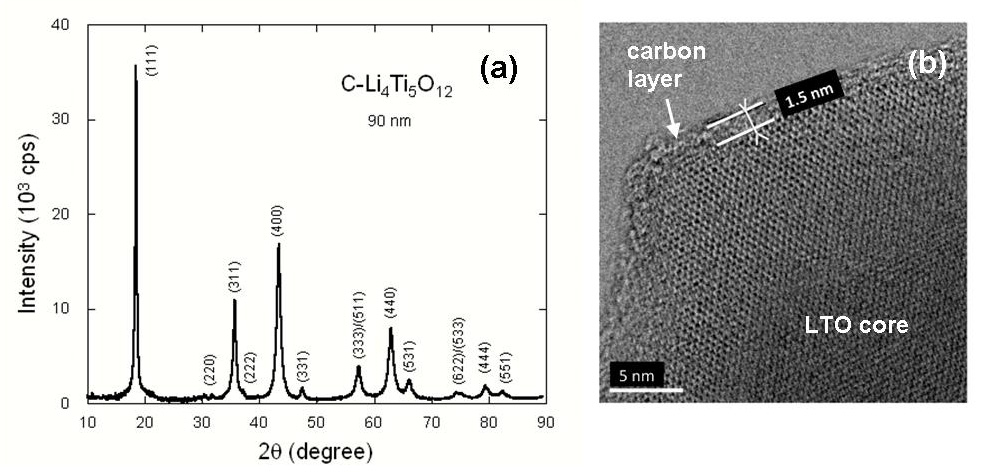 Figure 12. (a)X-ray diffractogram of carbon-coated LTO nano-particles (150 nm). (b) TEM image showing the carbon layer of the C-Li4Ti5O12 composite.
Figure 12. (a)X-ray diffractogram of carbon-coated LTO nano-particles (150 nm). (b) TEM image showing the carbon layer of the C-Li4Ti5O12 composite.
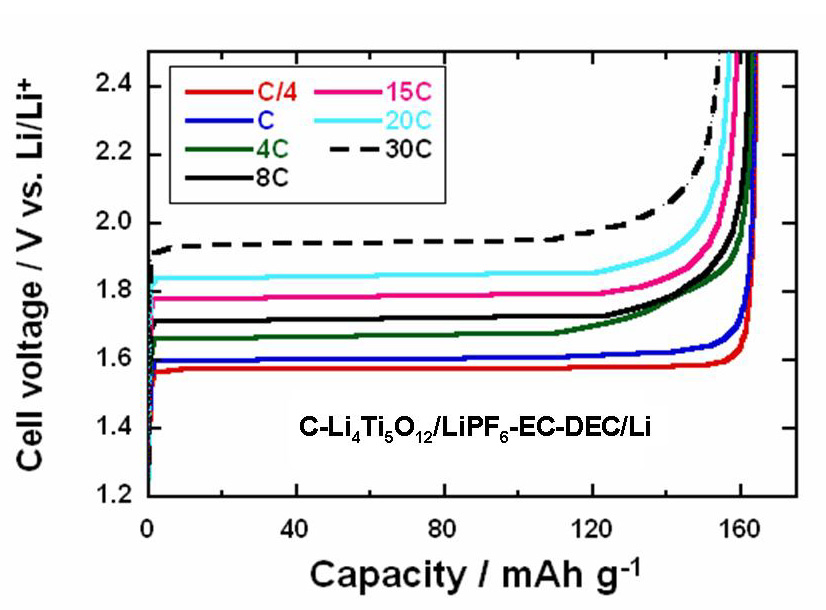 Figure 13. Charge curves of C-Li4Ti5O12 /1 mol L-1 LiPF6 in EC-DEC (1:1)/Li at different C-rates [28]. The electrode was deposited onto aluminum foil using 4 % water soluble binder plus thinner as bonder and 3 % VGCF, 3 % carbon as additive.
Figure 13. Charge curves of C-Li4Ti5O12 /1 mol L-1 LiPF6 in EC-DEC (1:1)/Li at different C-rates [28]. The electrode was deposited onto aluminum foil using 4 % water soluble binder plus thinner as bonder and 3 % VGCF, 3 % carbon as additive.
In this article, we have considered various smart materials used as electrodes in advanced Li-ion batteries. As this type of energy sources has become very promising to power electric vehicles and load-leveling applications, the development of new electrode materials requests update technology to provide electricity storage with long term stability. Advanced “smart systems” having very sophisticated structures were elaborated consideringseveral advantages with regard to low cost, non-toxicity, environmental friendless and high safety associated with remarkable chemical and thermal stabilities and tolerance to overcharge and over-discharge. These smart systems include surface modification, blending and nano-composites. Cathode and anode materials such as LiNi1/3Mn1/3Co1/3O2 (NMC), Li[Li0.1Mn1.85Al0.05]O4 (LMA), LiNi0.8Co0.15Al0.05O2 (NCA), LiMn2O4 (LMO), LiFePO4 (LFP), LiMnPO4 (LMP), and nano-Li4Ti5O12 have been considered.
There is no conflict of interest related to this document.
| [1] | https://en.wikipedia.org/wiki/Smart_material (2015) |
| [2] | Julien CM, Mauger A, Vijh A, et al. (2015) Lithium Batteries: Science and Technology. Springer, New York. |
| [3] |
Julien CM (2003) Lithium intercalated compounds, charge transfer and related properties. Mater Sci Eng R 40: 47–102. doi: 10.1016/S0927-796X(02)00104-3

|
| [4] |
Mauger A, Julien CM (2014) Surface modifications of electrode materials for lithium-ion batteries: status and trends. Ionics 20: 751–787. doi: 10.1007/s11581-014-1131-2

|
| [5] |
Hashem AMA, Abdel-Ghany AE, Eid AE, et al. (2011) Study of the surface modification of LiNi1/3Co1/3Mn1/3O2 cathode materials for lithium-ion battery. J Power Sources 196: 8632–8637. doi: 10.1016/j.jpowsour.2011.06.039

|
| [6] |
Lee JH, Kim JW, Kang HY, et al. (2015) The effect of energetically coated ZrOx on enhanced electrochemical performances of Li(Ni1/3Co1/3Mn1/3)O2 cathodes using modified radio frequency (RF) sputtering. J Mater Chem A 3: 12982–12991. doi: 10.1039/C5TA02055G

|
| [7] |
Thackeray MM, Johnson PJ, de Picciotto LA, et al. (1984) Lithium extraction from LiMn2O4. Mater Res Bull 19:179–187. doi: 10.1016/0025-5408(84)90088-6

|
| [8] |
Amatucci GG, Schmutz CN, Blyr A, et al. (1997) Materials effects on the elevated and room temperature performance of C-LiMn2O4 Li-ion batteries. J Power Sources 69: 11–25. doi: 10.1016/S0378-7753(97)02542-1

|
| [9] | Komaba S, Kumagai N, Sasaki T, et al. (2001) Manganese dissolution from lithium doped Li-Mn-O spinel cathode materials into electrolyte solution. Electrochemistry 69: 784–787. |
| [10] | Lee KS, Myung ST, Amine K, et al. (2009) Dual functioned BiOF-coated Li[Li0.1Al0.05Mn1.85]O4 for lithium batteries. J Mater Chem 19: 1995–2005. |
| [11] | Lee DJ, Lee KS, Myung ST, et al. (2011) Improvement of electrochemical properties of Li1.1Al0.05Mn1.85O4 achieved by an AlF3 coating. J Power Sources 196: 1353–1357. |
| [12] |
Chen Q, Wang Y, Zhang T, et al. (2012) Electrochemical performance of LaF3-coated LiMn2O4 cathode materials for lithium ion batteries. Electrochim Acta 83: 65–72. doi: 10.1016/j.electacta.2012.08.025

|
| [13] |
Jiang Q, Wang X, Tang Z (2015) Improving the electrochemical performance of LiMn2O4 by amorphous carbon coating. Fullerenes, Nanotubes and Carbon Nano 23: 676–679. doi: 10.1080/1536383X.2014.952369

|
| [14] | Sun W, Liu H, Bai G, et al. (2015) A general strategy to construct uniform carbon-coated spinel LiMn2O4 nanowires for ultrafast rechargeable lithium-ion batteries with a long cycle life. Nanoscale 7: 13173–13180. |
| [15] | Liu D, Trottier J, Charest P, et al. (2012) Effect of nanoLiFePO4 coating on LiMn1.5Ni0.5O4 5-V cathode for lithium ion batteries. J Power Sources 204: 127–132. |
| [16] |
Zaghib K, Trudeau M, Guerfi A, et al. (2012) New advanced cathode material: LiMnPO4 encapsulated with LiFePO4. J Power Sources 204: 177–181. doi: 10.1016/j.jpowsour.2011.11.085

|
| [17] |
Chikkannanavar SB, Bernardi DM, Liu L (2014) A review of blended cathode materials for use in Li-ion batteries. J Power Sources 248: 91–100. doi: 10.1016/j.jpowsour.2013.09.052

|
| [18] | Gao J, Manthiram A (2009) Eliminating the irreversible capacity loss of high capacity layered Li[Li0.2Ni0.13Mn0.54Co0.13]O2 cathode by blending with other lithium insertion hosts. J Power Sources 191: 644–647. |
| [19] | Tran HY, Täubert C, Fleischhammer M, et al. (2011) LiMn2O4 spinel/LiNi0.8Co0.15Al0.05O0.2 blends as cathode materials for lithium-ion batteries. J Electrochem Soc 158: A556–A561. |
| [20] |
Luo W, Li X, Dahn JR (2010) Synthesis, characterization and thermal stability of Li[Ni1/3Mn1/3Co1/3-z(MnMg)z/2]O2. Chem Mater 22: 5065–5073. doi: 10.1021/cm1017163

|
| [21] |
Ohzuku T, Ueda A, Yamamoto N (1995) Zero-strain insertion material of Li[Li1/3Ti5/3]O4 for rechargeable lithium cells. J Electrochem Soc 142: 1431–1435. doi: 10.1149/1.2048592

|
| [22] | Zhu GN, Liu HJ, Zhuang JH, et al. (2011) Carbon-coated nano-sized Li4Ti5O12 Yong-Gang nanoporous micro-sphere as anode material for high-rate lithium-ion batteries. Energy Environ Sci 4: 4016–4022. |
| [23] |
Wang YQ, Gu L, Guo YG, et al. (2012) Rutile-TiO2 nano-coating for a high-rate Li4Ti5O12 anode of a lithium-ion battery. J Am Chem Soc 134: 7874–7879. doi: 10.1021/ja301266w

|
| [24] |
Shen L, Li H, Uchaker E, et al. (2012) General strategy for designing core−shell nanostructured materials for high-power lithium ion batteries. Nano Lett 12: 5673–5678. doi: 10.1021/nl302854j

|
| [25] |
Choi JH, Ryu WH, Park K, et al. (2014) Multi-layer electrode with nano-Li4Ti5O12 aggregates sandwiched between carbon nanotube and graphene networks for high power Li-ion batteries. Sci Rep 4: 7334. doi: 10.1038/srep07334

|
| [26] |
Zaghib K, Dontigny M, Guerfi A, et al. (2012) An improved high-power battery with increased thermal operating range: C-LiFePO4//C-Li4Ti5O12. J Power Sources 216: 192–200. doi: 10.1016/j.jpowsour.2012.05.025

|
| [27] |
Jung HG, Myung ST, Yoon CS, et al. (2011) Microscale spherical carbon-coated Li4Ti5O12 as ultra-high power anode material for lithium batteries. Energy Environ Sci 4: 1345–1351. doi: 10.1039/c0ee00620c

|
| [28] |
Zaghib K, Dontigny M, Guerfi A, et al. (2012) An improved high-power battery with increased thermal operating range: C-LiFePO4//C-Li4Ti5O12. J Power Sources 216: 192–200. doi: 10.1016/j.jpowsour.2012.05.025

|
| 1. | Anna Isakova, Katarina Novakovic, Oscillatory chemical reactions in the quest for rhythmic motion of smart materials, 2017, 95, 00143057, 430, 10.1016/j.eurpolymj.2017.08.033 | |
| 2. | Prasant Kumar Nayak, Judith Grinblat, Mikhael Levi, Elena Levi, David Zitoun, Boris Markovsky, Doron Aurbach, Studies of a layered-spinel Li[Ni1/3Mn2/3]O2 cathode material for Li-ion batteries synthesized by a hydrothermal precipitation, 2016, 213, 09215107, 131, 10.1016/j.mseb.2016.04.012 | |
| 3. | Sara Taslimi Taleghani, Bernard Marcos, Karim Zaghib, Gaétan Lantagne, The Effect of Structural Properties of a Two-Layered Electrode on the Li-Ion Battery Polarization, 2019, 166, 0013-4651, A225, 10.1149/2.0681902jes | |
| 4. | Dewang Chen, Xiaoyu Zheng, Ciyang Chen, Wendi Zhao, Remaining useful life prediction of the lithium-ion battery based on CNN-LSTM fusion model and grey relational analysis, 2023, 31, 2688-1594, 633, 10.3934/era.2023031 | |
| 5. | Aadharshini G, Nisha Gupta, Prosenjit Saha, Pallab Bhattacharya, 3D Printing of MXenes-Based Electrodes for Energy Storage Applications, 2023, 05, 26895846, 1, 10.21926/rpm.2302020 | |
| 6. | Soumen Sardar, Kasilingam Rajkumar, Bharat Kapgate, 2023, Chapter 204-1, 978-981-16-4921-9, 1, 10.1007/978-981-16-4921-9_204-1 | |
| 7. | Jeremy I. G. Dawkins, Yani Pan, Mohammadreza Z. Ghavidel, Johann Geissler, Bastian Krueger, Danny Chhin, Hui Yuan, Victoria Tong, Brittany Pelletier‐Villeneuve, Renfei Feng, Gianluigi A. Botton, Karena W. Chapman, Janine Mauzeroll, Steen B. Schougaard, Exploring the Synergistic Effects of Dual‐Layer Electrodes for High Power Li‐Ion Batteries, 2023, 10, 2196-0216, 10.1002/celc.202300279 | |
| 8. | Soumen Sardar, Kasilingam Rajkumar, Bharat Kapgate, 2025, Chapter 204, 978-981-97-4617-0, 1109, 10.1007/978-981-97-4618-7_204 |